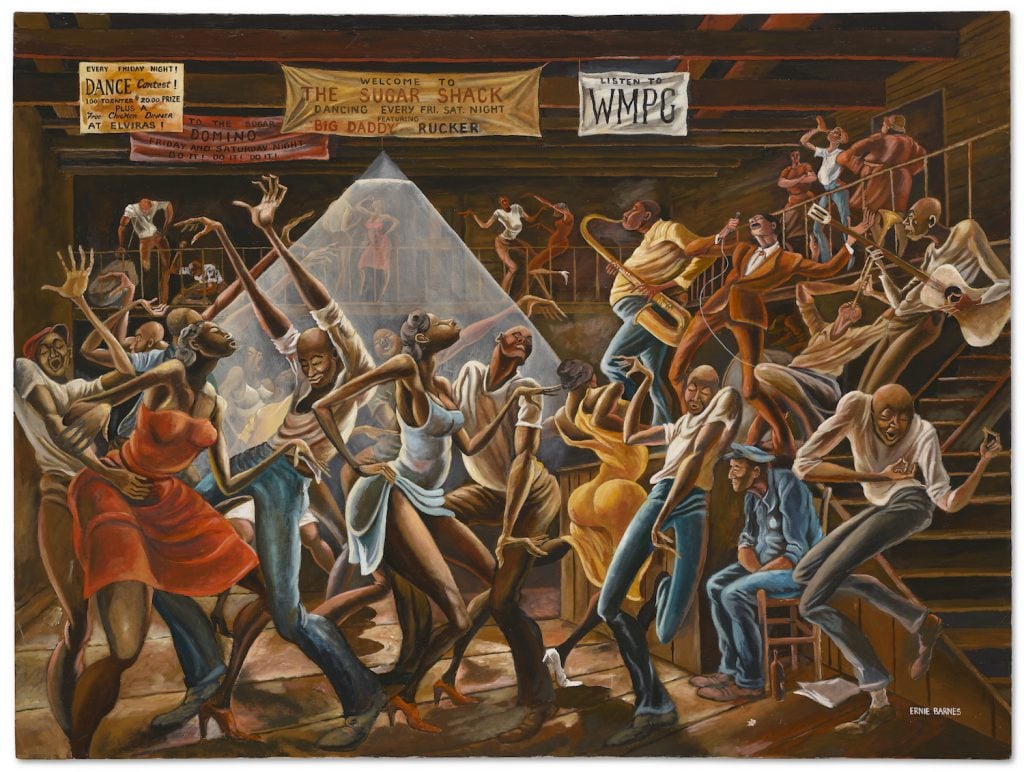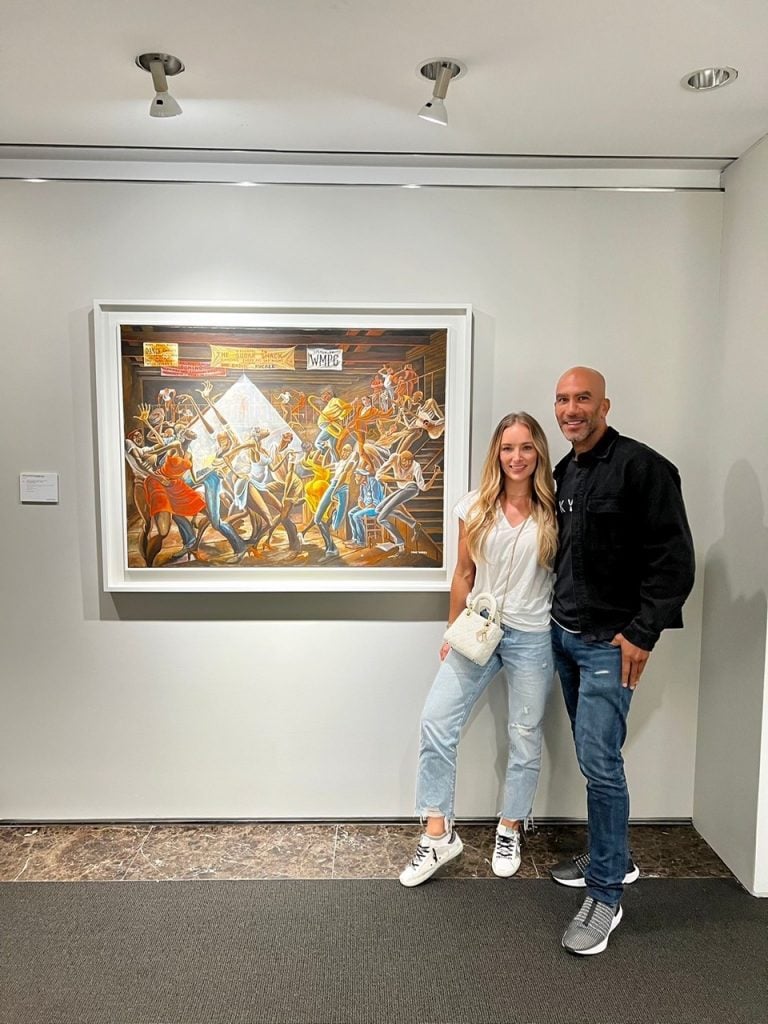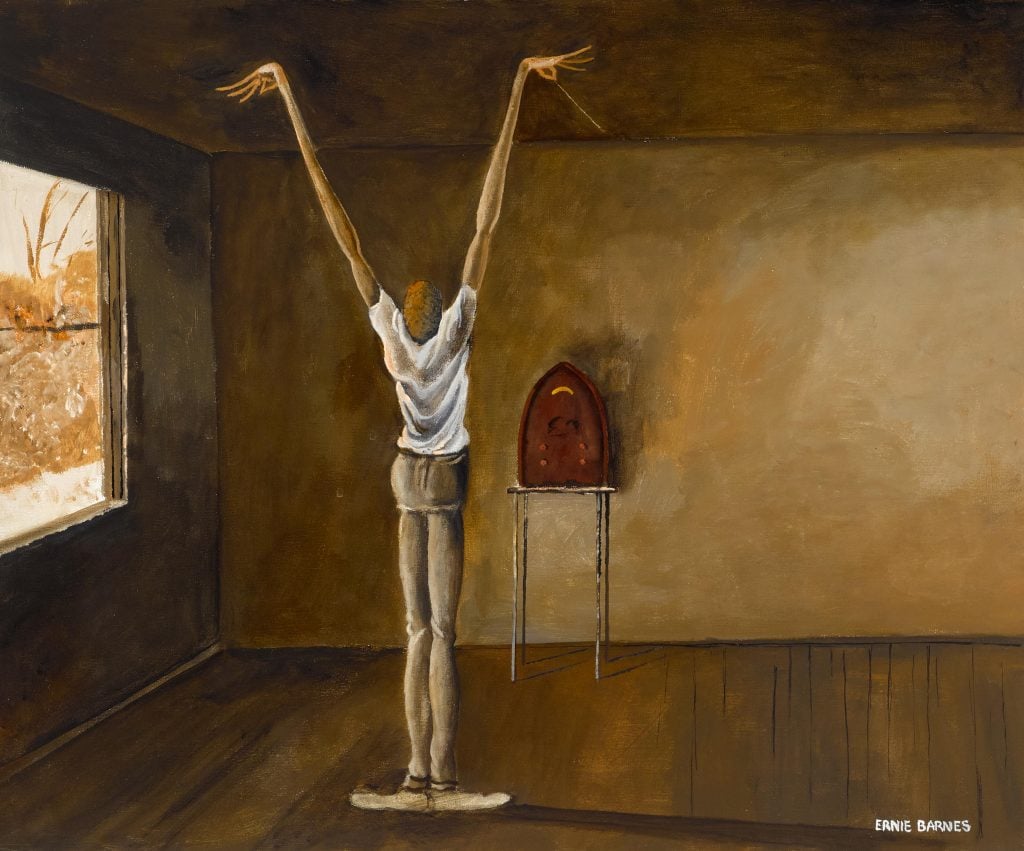Auctions
Ernie Barnes Stole the Show at Christie’s With His $15.3 Million Painting. Here Are 3 Things You Might Not Know About ‘The Sugar Shack’
The painting had a prominent role in the groundbreaking sitcom "Good Times."

The painting had a prominent role in the groundbreaking sitcom "Good Times."

Sarah Cascone

The unexpected star lot of last week’s Christie’s 20th century auction was The Sugar Shack, the most famous painting by Ernie Barnes. The 1976 work went for $15.3 million, or an astonishing 76 times its high estimate of $200,000.
A celebration of Black joy, the painting depicts an enthusiastic crowd of men and women with elongated limbs, seemingly carried away by the music as they dance the night away.
“The painting transmits rhythm, so the experience is re-created in the person viewing it,” Barnes, who died in 2009, said in an interview with the Soul Museum. “To show that African Americans utilize rhythm as a way of resolving physical tension.”
Ahead of opening the lot, auctioneer Adrien Meyer warned that there were “22 telephones” poised to enter the fray, but the winning bidder, Bill Perkins, made a special trip to New York from Houston to ensure he could bid in person.
Perkins won the day after a grueling 10 minutes of bidding—“it started and it just went nuts,” he told the New York Times, adding that when a rival bidder, identified by the Value as Dane Jensen of Los Angeles art advisory Gurr Johns, warned that he wouldn’t stop bidding, “I replied, ‘Then I’m going to make you pay.’”

Bill Perkins and his fiancée, Lara Sebastian, at Christie’s with Ernie Barnes’s The Sugar Shack (1976). Perkins won the work for $15.3 million after a lengthy bidding war. Photo courtesy of Bill Perkins.
Prior to the auction, the painting was in a private collection, having only had three owners since leaving the artist’s studio.
Christie’s cites a relatively sparse exhibition history, starting at a group show on Black art and cinema at London’s Whitechapel Gallery in 2004. It also appeared in shows of the artist’s work at the North Carolina Museum of History in 2018, and in Los Angeles at the California African American Museum (CAAM) in 2019 and UTA Artist Space in 2020.
The painting was last on view in New York in October, in a solo show devoted to Barnes at Andrew Kreps Gallery.
At CAAM, the work was identified as a loan from Jeannie and Jim Epstein, a Los Angeles attorney and his wife, according to Culture Type.
Here are three things that you might not know about the painting, the winning of which Perkins called “a childhood dream come true” on Instagram.
“This image has been in my consciousness since I was a kid. I have an emotional connection to it,” Perkins told Artnet News. No wonder: the work has major pop-cultural cred. It was commissioned by Motown star Marvin Gaye, whom Barnes met playing basketball. One day after a game, the singer-songwriter is said to have spotted a painting in Barnes’s car, and asked him to paint his next album cover.
The result was The Sugar Shack, featured on the cover of Gaye’s I Want You in 1976. The painting was Barnes’s second version of the composition, which he edited to add a reference to Gaye’s lead single on a banner hanging from the rafters of the crowded room.
The painting was additionally featured in the opening credits for seasons four through six of the classic sitcom Good Times (1974–79), which followed the lives of a poor family in the Chicago housing projects. The show broke ground as the first TV series starring an African American family and for its willingness to engage with politically charged issues of race and identity.
Barnes actually did all the artwork for the series, which costarred Jimmie Walker as oldest son J.J. Evans., a talented artist. But while Evans took the onscreen credit for Barnes’s work, the artist did guest star in two episodes of the show, in roles identified as “First Hood” and “First Hoodlum” on IMDB.
The primetime Emmy-winning television special Motown 25: Yesterday, Today, Forever, which aired on March 25, 1983, paid tribute to The Sugar Shack with a re-staging of the painting’s dance hall scene. The program was memorable for another cultural moment as well: Michael Jackson debuted his signature “moonwalk” dance.

Ernie Barnes, The Sugar Shack (1976). Courtesy of Christie’s New York.
Born in Durham, N.C., in 1938, as a child Barnes studied books on Toulouse-Lautrec, Delacroix, Rubens, and Michelangelo at the home of his mother’s employer, but because of segregation, it would be years before he was able to see such masterpieces in museums.
A talented athlete, he attended North Carolina College on a full sports scholarship and majored in art. There, his instructor, the sculptor Ed Wilson, helped Barnes tap into portrayals of his own lived experience. “(Wilson) told me to pay attention to what my body felt like in movement,” Barnes said. “Within that elongation, there’s a feeling, an attitude and expression. I hate to think had I not played sports what my work would look like.”
Barnes went on to play professional football for the Baltimore Colts, Denver Broncos, and other teams, and later found a patron in New York Jets owner Sonny Werblin. (He chronicled his transition from pro athlete to artist in his 1995 autobiography From Pads to Palette.)
For Sugar Shack, Barnes said he drew on childhood memories to paint the canvas, of a packed dance hall, Black men and women grooving with abandon to the sounds of an R&B band.
“I got the idea for Sugar Shack by reflecting on my childhood and not being able to go to a dance I wanted to go to when I was 11,” he told the Oakland Tribune in 2002.
The evocative image is considered part of the Black Romantic art movement, which was characterized by a deep sense of pride in the African American identity and its roots in precolonial African monarchies.

Ernie Barnes, Storm Dance (1977). Courtesy of Christie’s New York.
Barnes had previously only reached the $250,000 mark four times, topping out with the $550,000 sale of Ballroom Soul (1978), also at Christie’s New York, last November. (The Sugar Shack went for more than 27 times as much.)
But the artist’s top 18 auction results have all been achieved in the last two years, according to the Artnet Price Database—and three of those were last week.
On May 10, at Heritage’s “American Art Signature Auction” in Dallas, Pool Hall (ca. 1970) sold for $131,250, then the seventh highest price for Barnes at auction.
In the wake of the record-breaking Sugar Shack sale, Christie’s sold Storm Dance (1977) at its postwar and contemporary art day sale for $2.34 million on May 13, exceeding the high estimate of $150,000 by 1,460 percent. The long and narrow canvas echos the subject, a group of lanky Black men leaping toward a makeshift basketball hoop, the game frozen in time as a guard attempts to block an opponent from dunking.

Ernie Barnes, The Maestro. Photo courtesy of Bonhams, © Ernie Barnes Family Trust, collection of the Los Angeles Athletic Club.
A glut of Barnes works have come to the block since June 2020, with 38 altogether—33 percent of the 115 works by the artist ever offered at auction.
Prior to that month, a Barnes work had never fetched more than $47,500, the price set at New York’s Swann Galleries in October 2017 for The Maestro (ca. 1978).
An earlier painting by the same name, from the collection of the Los Angeles Athletic Club, is set to come up at Bonhams New York on May 26. The circa 1971 acrylic painting was used by the Crusaders for the cover of their 1984 album Ghetto Blasters. At Bonhams, it carries a high estimate of $35,000—but with the way things are going, the final number could be much, much bigger.